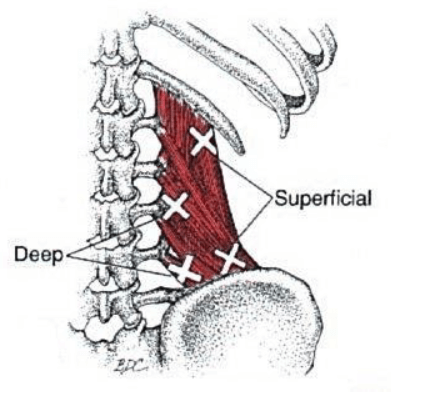Does your lower back hurt? Are you wondering if it could be caused by trigger points?
Well let me help you answer those questions. Here’s what I will be talking about in this post.
- What is a trigger point?
- Why do you get trigger points in your lower back?
- How do you release trigger points?
What is a trigger point?
A trigger point is a hyper-irritable nodule of tissue bound in your muscle fibers. It refers pain to other locations of the body and can encourage various symptoms. Trigger points are painful when pressed on by touch. At a micro level, the muscle fibers are actually getting frozen together.
Two key components of the sarcomeres are Actin and Myosin – the smallest contracting units of the muscle fibers. These two interlocking mechanisms get frozen together and need to be broken up.
“Healthy muscle tissue should not hurt when pressed.” Said my now-passed, trigger point teacher, John Harris. Healthy tissues should also be able to glide and slide around each other during movements. They should have easy flow of blood and lymph. But when a trigger point is present, these healthy functions are obstructed, which causes pain.
Why do you get trigger points in your lower back?
Trigger points will form from a need to keep muscles contracted. If you overuse a muscle, have an injury or hold your tissues in a closed posture for long periods of time, then you could create a trigger point.
Overuse is a common problem these days. Not only with sports, but in the workplace as well.
Think of any movement which you may perform dozens, hundreds or thousands of times each day. Moving your computer mouse, typing on the keyboard or pressing the foot petals as you are driving your car. Perhaps you play a sport like golf. You swing the club over and over again in the same way. You use all your power on those big drives.
Injury is an unfortunate cause of trigger points. Anytime you hurt yourself your body will reactively protect the injured area. It commonly does this by restricting movement.
Tightening muscles and locking down your range of motion is a useful protective tool at first. But if your body stays in lockdown mode for a long time, this can create trigger points and problems.
Posture will shorten your muscles and cause trigger points simply by keeping the muscle fibers closed for a long time.
Do you ever feel stiff after watching a movie or reading a book? You sit down for a few hours and then when you stand up you find yourself needing to stretch. You need to undo the closed muscle fibers after staying sedentary for so long. So let’s put those three causes together.
How do you release trigger points?
There have been many methods used over the years to remove the trigger points from your body. Sprays, injections, electrical stimulations, but the easiest and most common method is to massage the trigger point.
If you can use a technique called Self-Myofascial Release, which only means massaging your own muscles, then you can easily release the trigger points without a fancy treatment.
Lower back trigger point release technique advice
Trigger points usually start to release after about thirty seconds of mild pressure. You can apply static pressure or slight friction to the point. I recommend staying on a point for at least 2-3 minutes or until the pain decreases.
You should feel a noticeable change in the symptoms as you release the point.
Tools for releasing trigger points
You can release trigger points with a few different tools.
- Your own hands if you can reach.
- A theracane is very useful and cheap.
- Tennis balls, or if you are willing to spend a little more money then buy a YogaTune Up ball.
- Don’t use the lacrosse balls, they are too hard and can cause bruising.
- Melt foam rollers are the best because of how soft and light they are.
With any of these tools, you can release your own trigger points.
Lower back trigger points chart
Here are some photos of releasing trigger points and the anatomy.




